
Most people don’t realize how much revenue quietly slips away in copy-paste tasks… until an automation starts catching every drop. In this guide you learn a simple pattern that links your apps, moves data cleanly, and runs while you build the business.
The outcome is tangible: a working workflow today, and a roadmap to scale with confidence tomorrow. Albato makes this possible with a visual builder, webhooks, and an optional custom API connector, starting on a free tier and scaling by transactions you can control.
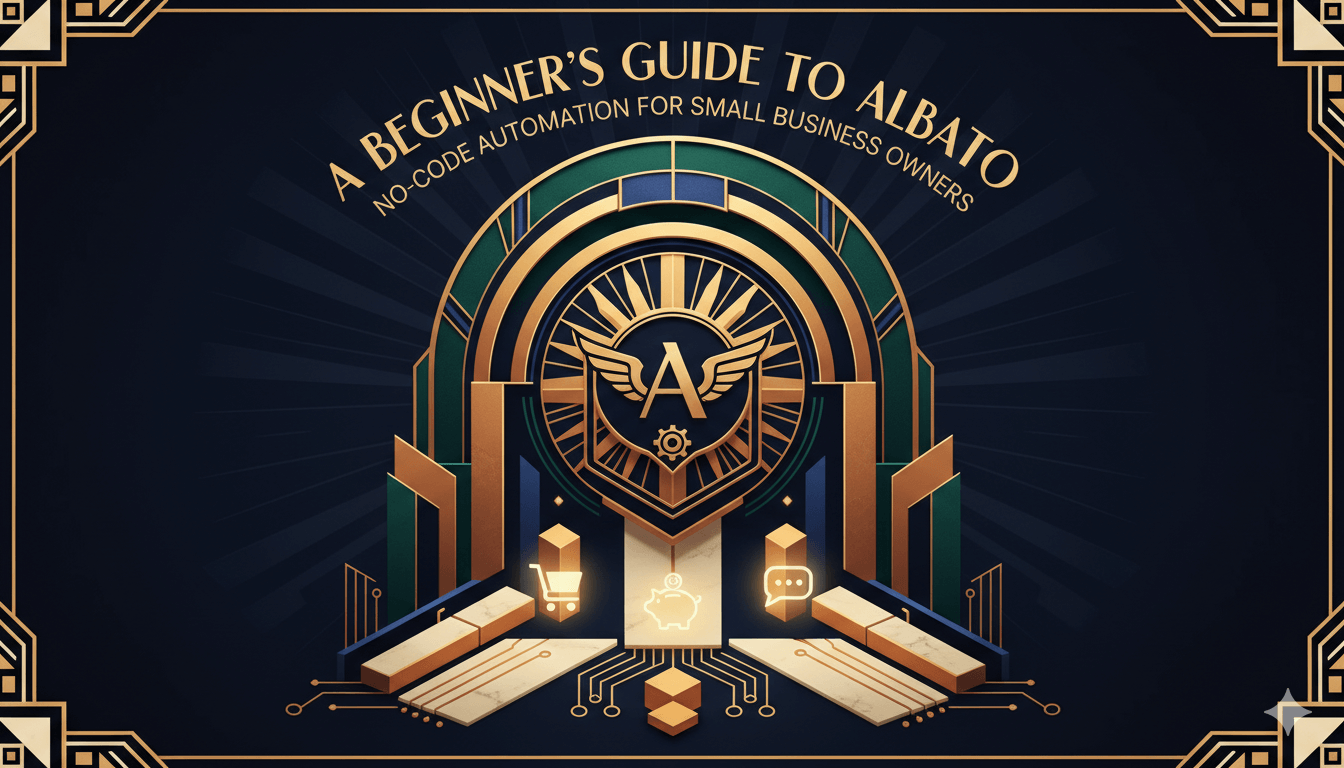
What Albato is and why it matters
If your apps could talk, what would they say—and do—on your behalf? Imagine sales forms greeting your CRM, your email list, and your accounting in the same breath… quietly, accurately, every time.
Why it matters: Albato is a no-code iPaaS. You connect apps, define a trigger, add actions, and Albato moves the data. You start free, then scale by transactions with the option to buy add-ons during spikes instead of upgrading plans.
The platform covers core concepts such as webhook and API triggers, field mapping, filters, duplicate control, schedules, and run History so non-technical owners ship fast and troubleshoot with clarity.
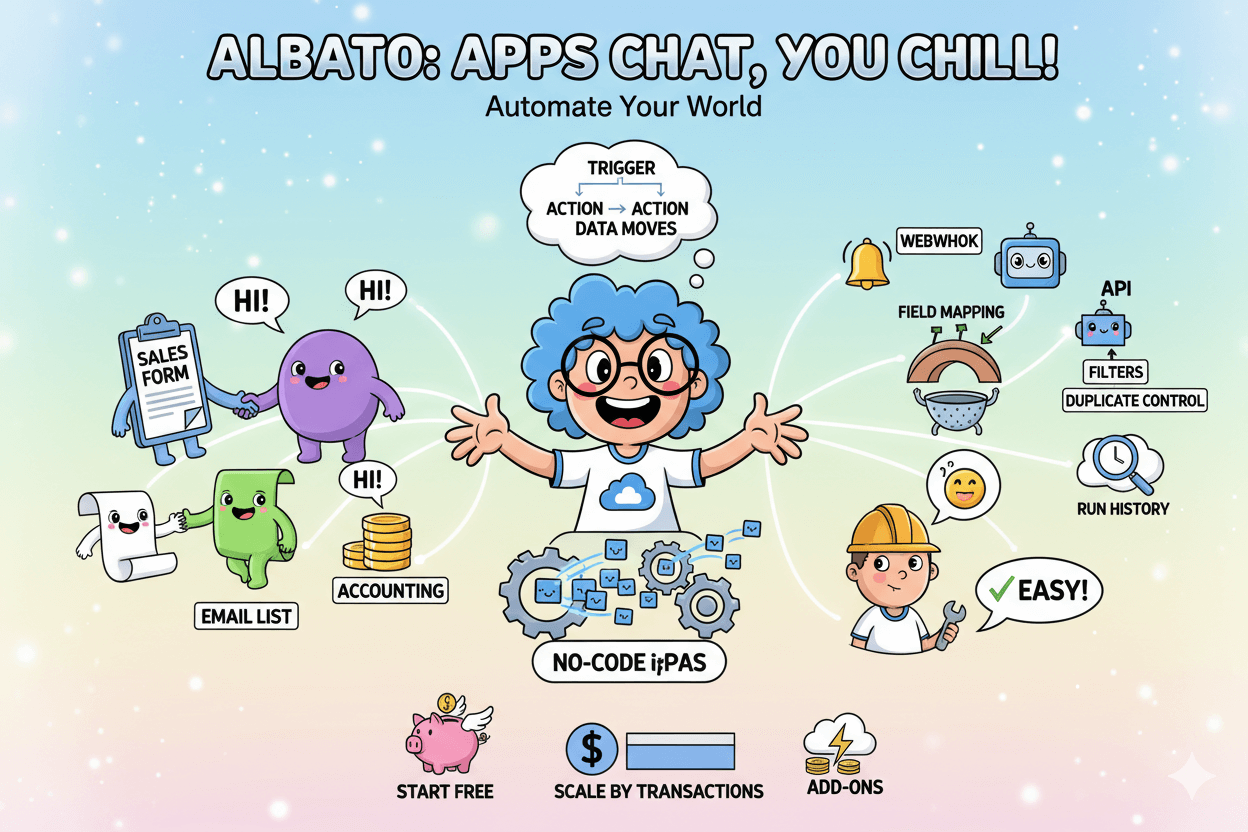
A Beginner’s Guide to Albato: No-Code Automation for Small Business Owners — essentials
What you’ll use daily
- Triggers and actions inside a visual scenario builder.
- Webhooks for real-time capture from forms, shops, and ads.
- History to audit payloads and replays.
- Optional App Integrator for REST APIs not yet in the catalog.
Did you know? Albato lists 1,000+ apps and 170,000+ ready scenarios to accelerate setup. Albato
Fast start: build a 15-minute lead-capture flow in Albato
Most owners lose hours to copying data between forms, inboxes, and spreadsheets. Your first Albato automation gives that time back in a single pass: a form fires, a lead lands in your CRM, a sheet logs the record, and a confirmation goes out—without code.
The builder walks you through trigger → actions → test → on, so you can focus on selling instead of shuffling. Webhooks make it instant. History shows every step, so you can trust the result. Start free, then scale by transactions when volume grows. Fifteen minutes to first value is realistic if you follow the checklist.
Context: Create an Incoming Webhook trigger, then push the contact into your CRM, your email tool, and a Google Sheet, followed by a confirmation message. This pattern scales from ten to ten-thousand leads without changing the shape of your workflow.
Steps
- Create the webhook trigger. Add the Webhook app and copy the generated URL. Click Wait for webhook and send a test from your form tool or Postman; Albato captures the payload for mapping.
- Map fields. Match name, email, phone, campaign, and UTM data to your CRM and ESP fields. Set duplicate rules on the email field to avoid clutter.
- Add actions.
- Upsert contact in your CRM.
- Subscribe the email to a list.
- Append a row to Google Sheets for an “Automation Log.”
- Send confirmation to the lead via your preferred channel.
- Add protection. Insert a Filter: email present AND consent = true.
- Verify in History. Inspect the run, confirm success codes, and replay failed tasks if needed. Turn the scenario on.
Quick win: Screenshot sequence to include: Webhook URL → test payload → field mapping → History run with green checks.
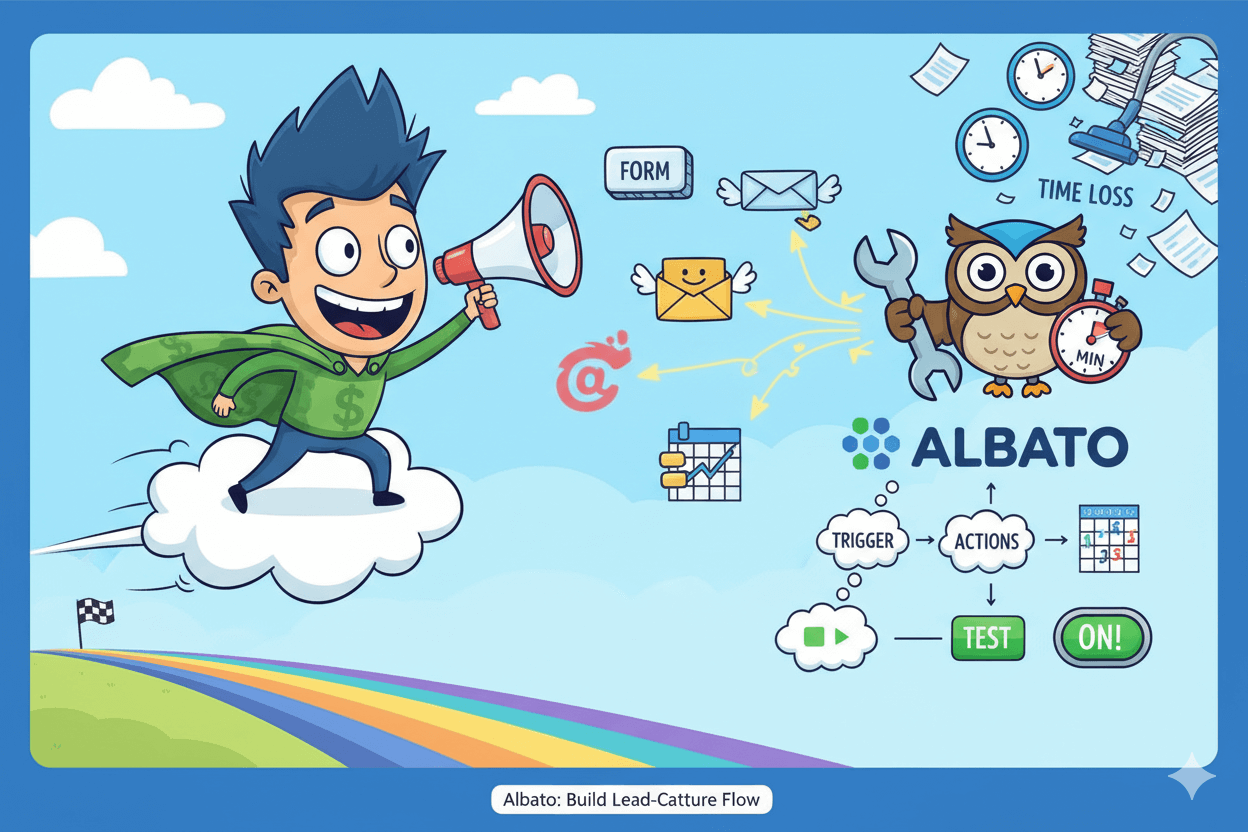
Pricing without surprises: transactions and add-ons
Budgets breathe easier when costs match work done. Albato’s pricing scales by transactions and lets you buy add-ons during spikes, so you validate ROI before upgrading.
Build a tiny revenue-adjacent workflow first—lead to CRM, email, and sheet—then watch usage. When you pass the allowance, top up; when growth holds, step up a tier. Simple math. Clear levers. Better control.
How it works: Albato’s public pricing shows a free tier and paid plans that scale by monthly transactions. If you spike beyond your allowance, you can purchase additional transactions on the billing page instead of moving up a tier.
Higher plans reduce polling intervals, but you can keep early costs tight while you validate ROI.
Practical guardrails
- Start free to validate the flow.
- Track your transaction burn weekly.
- If volume spikes temporarily, buy add-ons; if volume sustains, upgrade later. Albato
Sample month math
- 100 leads: One trigger + three actions ≈ ~400 transactions.
- 1,000 leads: ≈ ~4,000 transactions.
- 10,000 leads: ≈ ~40,000 transactions.
Use your real step count and multiply by expected volume. Keep polling to a minimum and prefer webhooks to avoid unnecessary checks.
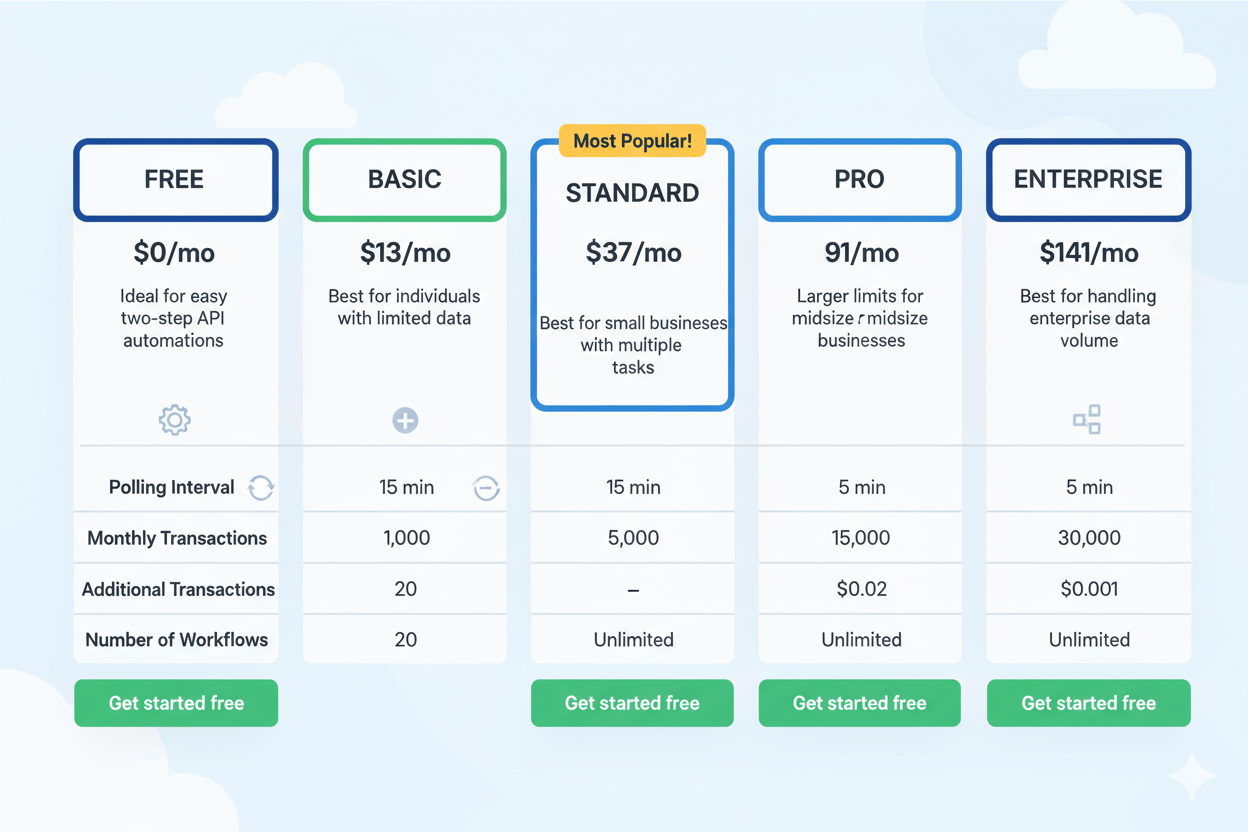
Webhooks for non-coders: real-time beats waiting
Polling waits. Webhooks deliver now. Generate a URL, click Wait for webhook, send a test, then map fields once. From that moment, every qualified lead fans out to CRM, email, and a sheet in real time. Faster follow-ups mean fewer missed opportunities.
Why webhooks win: Albato’s Webhook app provides a ready endpoint to capture events, connect with 1,000+ apps, and orchestrate actions immediately. For lead capture and orders, this beats interval checks and cuts data lag.
Design patterns
- Per-source URLs to tag and trace campaigns.
- Validation filter: email present, consent true.
- Fan-out to CRM + ESP + Sheet + message in one scenario.
Document each with a small sequence diagram inside the article.
App library and templates that reduce setup time
Why start from zero when a gallery of ready scenarios exists? Albato’s directory lists 1,000+ apps and step pages like Google Sheets + Webhooks that shave setup time to minutes. Pick a template, map fields, add a filter for consent, and ship.
The fastest wins live in templates.
What to expect: Albato maintains “Connect X with Webhooks” pages and individual app connectors. These pages show trigger and action options, then walk you into a guided setup.
Pair that with a lightweight “10 steps to live” checklist and you speed through your first build.
Examples worth showcasing
- Email + Webhook for instant confirmations.
- JavaScript + Webhook for custom front-end events.
- Stackby + Webhook or similar to log operational metrics.
Each example follows the same choreography: choose trigger → map → test → turn on.
Custom connectors with App Integrator
Your must-have app missing from the catalog? Use App Integrator to paste endpoints, auth, and objects from the API docs. You get a working connector without a dev handoff. For one-offs, insert a Custom API request inside a scenario and keep moving.
How it works: The App Integrator lets you copy details from an API doc and create your own connector with auth, endpoints, and objects. Keep it private for your workspace or submit it for publication if you want others to use it. The Custom API request feature crafts calls inside a scenario without building a full connector—ideal for smaller needs.
Starter checklist
- Gather base URL, auth type, required headers, and sample payloads.
- Configure a Trigger or an Action with the method and path.
- Map response fields and test for a 200 OK with expected JSON.
- Document rate limits and errors in a short note for future reference.
Data quality: filters, duplicates, and history
Good automations are invisible because the data is clean. Quiet precision… no messy lists, no double charges, no ghost contacts.
Three simple habits
- Filter first. Only proceed if
emailexists andconsent = true. - Deduplicate at the source. Use your CRM’s unique key and prefer upserts over blind creates.
- Audit with History. Read payloads, confirm step results, and replay safely.
Micro-challenge: Before you scale, open History and trace one lead from webhook to sheet. Confirm fields match exactly. Albato
Three SMB recipes you can copy today
Steal these playbooks and ship in an hour. Each one compounds time and trust.
1) Booking → CRM + team chat + invoice draft
- Trigger: New booking event from your calendar tool.
- Actions: Upsert contact and meeting note in CRM → send a team alert → create a draft invoice in your docs or billing app.
- Twist: Add an AI step to summarize the booking intent into the CRM note for the next touch. Albato supports AI steps and connectors for this.
2) Ecommerce order → accounting + fulfillment + receipt
- Trigger: New paid order.
- Actions: Create an accounting entry → open a fulfillment task → email the receipt → append a revenue row into your sheet for daily reconciliation.
- Tip: Keep SKUs and taxes as separate mapped fields for clean reporting; use webhooks whenever your platform supports it.
3) Support ticket → priority route + notify + first-reply draft
- Trigger: New ticket or status change.
- Actions: If
priority = urgent, assign to the right owner and alert a channel; generate an AI draft reply for agent editing. - Result: Faster first responses without losing human judgment.
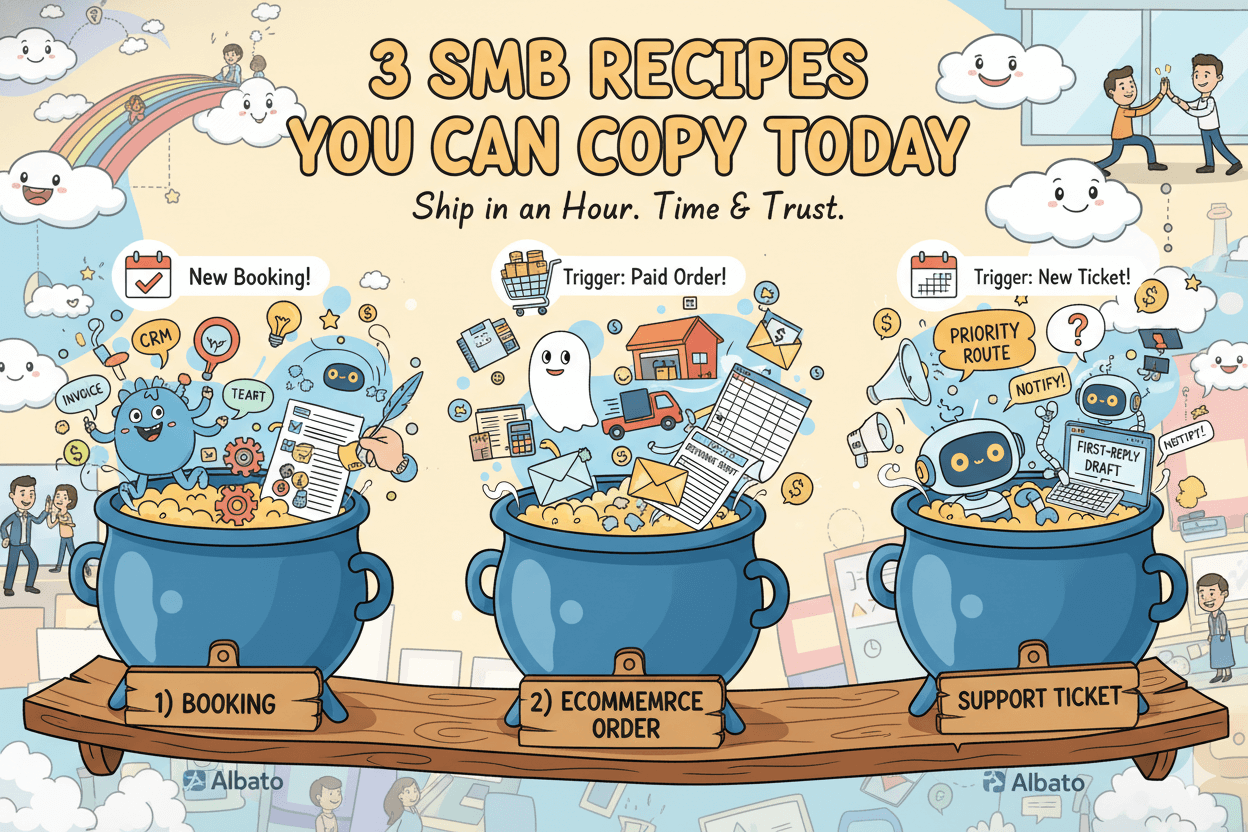
Learning path: from first scenario to confident operator
Skills compound. Systems scale. Today’s tiny flow becomes tomorrow’s quiet machine.
Week-one syllabus
- Day 1–2: Albato Basics. Learn triggers, mapping, filters, schedules, execution modes, and History. Build one scenario end-to-end.
- Day 3–4: Add a webhook and a filter. Open History and practice replays.
- Day 5–7: Clone your first scenario and swap apps; document fields and error states.
Albato Academy provides a concise path that fits a busy calendar.
Social proof and trust signals
Proof reduces risk when you are busy and cautious. You want clarity before you commit.
Signals to consider
- Transparent plan mechanics and the ability to buy transaction add-ons when demand surges.
- Public product education through Albato’s Academy and help wiki, which lowers onboarding friction for teams. Albato
Context for 2024–2025: why automation now
The tide is moving. Adoption is rising, and the gap between doers and waiters widens every quarter.
- AI and automation adoption is climbing. McKinsey’s 2025 update reports most organizations using AI in at least one function, with broad use across IT, marketing and sales, and service operations. McKinsey & Company
- Cost outcomes trend positively. The latest McKinsey survey notes a majority of respondents report cost reductions from gen-AI in business functions that use it. Treat AI inside automations as a small-step enhancer rather than a silver bullet.
- Low-/no-code keeps expanding. Albato’s growing app catalog and template library reflect the wider shift to practical no-code adoption for SMBs.
Practical takeaway: Start small, measure transactions and hours saved, and expand where ROI appears first.
Smart pitfalls to avoid
- Skipping filters. Always require
emailandconsent = truebefore writing to downstream tools. - Relying on polling when webhooks exist. Use webhooks for leads and orders to cut lag and reduce checks.
- Ignoring transaction math. Multiply steps by expected events, watch usage weekly, and buy add-ons during brief spikes.
- Building the perfect system first. Ship a small revenue-adjacent flow, then iterate.
Comparison thinking without the noise
You want clarity, not debates. The best tool is the one that fits your constraints today and scales just enough for tomorrow.
How to decide with integrity
- Cost control: Plans scale by transactions; add-ons reduce commitment while you find traction.
- Coverage: Use the app gallery and “Connect X with Webhooks” pages to verify triggers and actions you need.
- Ceiling: If your stack includes niche or regional software, test App Integrator or Custom API request early so you know the escape hatch works.
Accessible implementation checklist
A clear checklist reduces cognitive load… and reduces errors.
- Name scenarios clearly with the business event first.
- Document fields: which payload field maps to which destination field.
- Add filters before writes; confirm consent and required fields.
- Use webhooks for real-time events when available.
- Test with real samples and check History for each step.
- Track transactions weekly and set a reminder to review usage. Buy add-ons if you spike.
- Prepare screenshots with alt text for accessibility.
- Provide a short fallback path when an app is missing: App Integrator or Custom API request.
Conclusion
Quiet systems build loud momentum. The less you touch the busywork, the more you can shape the business.
Recap: You learned how Albato structures automations, why webhooks create real-time leverage, and how to budget using transactions and add-ons. You built a 15-minute lead-capture flow, reviewed three copy-ready SMB recipes, and saw how App Integrator or Custom API requests keep you moving even when an app is missing. You have a week-one learning plan and a simple checklist for clean data.
Next step: Open Albato, create the Webhook trigger, send a test, and map fields for your primary lead source… then watch the first confirmation arrive without lifting a finger.

Albato
FAQs that match search intent
Is there a free version of Albato?
Yes. Albato lists a free tier on its pricing page. You can also purchase additional transactions if you temporarily exceed your allowance. Confirm current caps before purchase.
How does Albato work without code?
You connect apps, choose a trigger, add actions, and map fields in a visual builder. Webhooks capture data in real time; History lets you audit and replay.
What if the app I need isn’t listed?
Use the App Integrator to build a connector from API docs, or insert a Custom API request as a smaller step.
Where should I start as a beginner?
Follow the 15-minute lead-capture pattern: Webhook → CRM + Email + Sheet + confirmation. Validate with test data and History before scaling.




